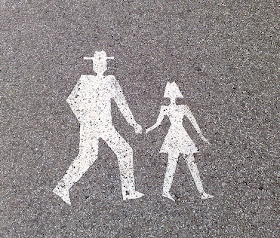Pages
▼
In Our Partners' Heights, We Get What We Want
If you ask most heterosexual people what height they're looking for in a partner, they'll describe basically what a children's-book illustrator would draw: the man taller than the woman but not towering over her. But those of us who aren't pen-and-paper must settle for real human partners in human shapes and sizes. Nevertheless, new research says most people end up with a reality that matches the fantasy.
Researchers led by Gert Stulp of the University of Groningen in the Netherlands wondered whether people's professed height preferences matched who they ended up with. Earlier studies had shown that within Western cultures, there are clear trends: Taller people are interested in other tall people; shorter people like short people. And both sexes prefer that the male be taller.
But not too tall! One study combed through thousands of personal ads from a dating site that let users indicate the tallest and shortest person they'd consider dating. On average, women said they weren't interested in men more than 17% taller than themselves. For a 5-foot-5 woman, for example, that means a man over 6 foot 4 seems like a little much.
To compare these preferences to a real population, Stulp and his coauthors used data from the Millennium Cohort Study, a broad sampling of almost 19,000 babies born in the United Kingdom in the year 2000. Among other things, the parents of these babies had been asked for their heights, and 12,502 couples had answered the question.
To see what it would look like if people paired off with no regard to height, the researchers created 10,000 random reshufflings of their UK couples. They then compared these chance pairings to reality.
First, they tested whether people seek out their own kind. Sure enough, taller people had taller partners, and shorter people had shorter partners.
The next question was whether people really care about the man being taller. Of course, since men are on average taller than women, randomly pairing people off is likely to get you a taller male anyway. In the randomized UK couples, the male was taller 89.8% of the time. But in reality, 92.5% of couples had a taller male, a significant difference. And when the woman was taller, it was likely to be only by a tiny bit.
Finally, people say they prefer height differences that aren't too exaggerated. But do they follow through? The authors looked for height gaps of 25 centimeters or more. In the random pairings, this occurred in 15.7% of couples. But in real life, only 13.9% of couples had a height difference this huge.
More often than chance would predict, these couples had followed traditional height preferences. That suggests that when we choose our partners, height does matter.
The study doesn't address the preferences (or reality) of couples who are not heterosexual, not parents, or not in the United Kingdom. Stulp says research has shown that across Western cultures, heterosexual people report very similar preferences for a partner's height. (The Netherlands, where the 6-foot-7 Stulp lives, is home to the tallest people in the world. But he says he believes height preferences in this land of giants are the same, just shifted upward.) In non-Western cultures, he says, those preferences are slightly different and more variable.
Stulp, in fact, was surprised that height preferences didn't have an even stronger affect on the results. He expected reality to be further from random chance than it was. But, writing in PLOS ONE, he acknowledges that many factors affect our choice of partner. "Height," he writes, "is but one of many characteristics valued in a mate."
Stulp, G., Buunk, A., Pollet, T., Nettle, D., & Verhulst, S. (2013). Are Human Mating Preferences with Respect to Height Reflected in Actual Pairings? PLoS ONE, 8 (1) DOI: 10.1371/journal.pone.0054186
Image: Peter Rukavina (Flickr)

No comments:
Post a Comment
Markup Key:
- <b>bold</b> = bold
- <i>italic</i> = italic
- <a href="http://www.fieldofscience.com/">FoS</a> = FoS
Note: Only a member of this blog may post a comment.